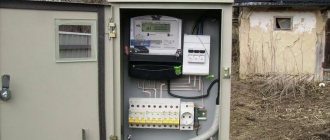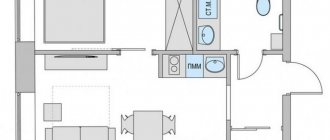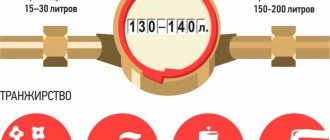Expert author of the article
Yuri Grigorievich F.
Energy Engineer. 40 years in the profession, head of the bureau, deputy chief power engineer of the plant, chief specialist.
A modern electricity meter is a fairly reliable device. He can do his job for years without causing problems for his owners. But if suddenly the amount shown on the receipt has increased significantly, then reasonable doubts arise about its objectivity.
It is urgent to check the meter for correct readings. Otherwise, you will have to spend money on overpayment or a fine for concealing a fault.
In what cases are metering devices verified?
Induction and electronic devices have an operating life that is set by the manufacturer. For metering devices with a magnetic disk it is 8-10 years. Electricity meters: “Energomera”, “Niva”, etc. are verified every 16 years. Technical measures can be carried out earlier if there is reason to doubt that the metering device is damaged.
The timing of verification of electricity meters is indicated in the technical documents attached to the device. The initial work is carried out by the manufacturer. Based on the results of the procedure, the metrologist draws up a report on the suitability of the electric meter for use or the need for replacement (indicating its shortcomings). It must be checked at your place of residence and not necessarily at the company recommended by utility services. To install an electricity meter, you need to use the help of an electrician.
Frequency of verification according to law
There is no single set deadline for the verification period of electric meters. It must be looked at in the technical passport. Federal Law No. 102, the law on energy saving, does not prohibit the purchase of a new device during the calibration interval, without conducting metrological tests of the old one. The homeowner must focus on the technical documentation and promptly invite a specialist from the supplier company to draw up a report. The verification period for electric meters is usually at least 8 years.
Unscheduled inspection
You will need to check the electricity consumption meter if there is reason to doubt the correct operation of the electricity meter.
For this you will need:
- make sure that the wiring is connected correctly;
- invite a specialist to draw up a certificate of removal of the electric meter and send it for metrological tests. The exact verification period must be found in the device passport;
- submit payment receipts.
Unscheduled measures will be needed when documents confirming a previous inspection are lost, or when it is necessary to set up and adjust the electric meter.
The corresponding activities are carried out by inspectors who compare the readings with the information specified in the calculation databases. It is necessary to check the electric meter if the device fails.
Thief identification check
If you have already realized that electricity is being stolen, you need to catch the thief. For this:
- On the site, unscrew the plugs in your panel (you will not have electricity in the apartment, at the same time, the thief’s devices, which are powered by you, will no longer be powered);
- Go one floor higher, or go into the apartment and look through the peephole;
- It may take a lot of time, but sooner or later the thief will want to turn on your panel.
You will see someone come and screw in the plugs in your panel so that you can use your electricity again. Catch the thief! It is he!
These simple algorithms for checking the accuracy of your meter readings and checking for electricity theft will help you determine if you are paying too much. And if this is the case, then get an official conclusion to change the meter for free (in case of high measurement error). And when identifying a thief, it will be easier for you to prove the fact of theft.
How to check the meter with removal and at home and how this is documented
To check the correct operation of the electric meter at home, you need to make sure that there is no load on the devices and exclude the self-propelled movement of the induction disk. Devices and machines are turned off - the owner makes sure that electrical appliances do not create a load on the indicators.
The error of changes is calculated using a multimeter, current clamps or an incandescent light bulb. It is advisable to check the electric meter at home using a light bulb with a standard power of 100 W.
Necessary:
- Measure the voltage in the outlet with a multimeter and write down the value (e.g. 225 W)
- Measure the current of the light bulb (in amperes) - e.g. (0.47 A)
- Find out the size of the error in the operation of the electric meter; it should not be more than 10% of the technical characteristics of the lamp power.
You should check the device yourself if you have special knowledge. The act must be drawn up with the participation of a specialist.
When to check the accuracy of your electric meter readings?
You can check the operation of the electric meter at any time. But there are cases when this is necessary:
- Energy consumption has increased sharply. But you did not purchase new electrical appliances, and the same number of people live in the apartment. Pay attention to seasonal features: in summer you can use the air conditioner for a long time, and in winter you can use the heater (they can increase electricity costs);
- Consumption did not decrease during your long absence (you went on vacation for 3-4 weeks) or decreased only slightly;
- You don't have many powerful home appliances that can use so much energy.
Attention! If you do the check yourself at home, it will not have legal force. It can only show whether the counter is overinflating. And if the check shows that this is the case, then an official verification will be required at a special institution, which will give an opinion on the accuracy of the readings of the counting device.
Types of meter checking
They can be planned or forced. Checking metering devices for consumed electricity is carried out in different ways (testers, current clamps, incandescent light bulbs). The goals of the event also differ. You can check the device to establish the fact of energy theft, or to determine whether the device is operating correctly. The readings are taken by the apartment owner or competent specialists.
Checking the correct connection
It is necessary to check the electric meter, taking into account the fact that it is connected to the network with four terminals. The phase comes from the leftmost terminal and then electricity flows into the apartment through the remaining conductors. In private houses, three-phase devices are installed (the phase will be connected to terminals 1, 3, 5). Electricity enters the distribution panel through 2, 4, 6 terminals. Terminals 7 and 8 are allocated to the neutral wire.
Self-propelled test
It is possible if electricity consumption increases when household appliances are turned off. In order to check the correct operation of the electric meter, you must:
- turn off all devices;
- turn off machines;
- Watch for the disc to move or the indicator to flicker. 1 revolution is allowed in 10-15 minutes or one flicker in the same period. Exceeding the indicators indicates technical malfunctions or manufacturing defects.
If the electric meter continues to write indicators, then you should pay attention to the fact of illegal connection to the network, including using “left wiring”.
Check for theft
Signs of energy theft may be deformation of the electric meter body - in order to insert a needle and slow down the rotation of the disk. It is practiced to purposefully squeeze the glass out of the electric meter in order to insert retaining devices to slow down the movement of the disk. If there is no seal, the tension screw is loosened. You should also check the machine in the control panel on the landing, turn it off and observe the behavior of neighbors who, using hidden wiring, can steal electricity.
Checking magnetization
Checking the electric meter, if there is an anti-magnetic seal on it, will not be difficult. The color of the sticker or indicator will change. You can also detect magnetization using a needle; if it is attracted to the panel, it means that they tried to open the meter. The electric meter will begin to work normally 2-4 days after removing the magnet. To speed up the process, you can use an anti-magnetic device.
Checking that the meter is connected correctly
Before checking the accuracy of the electricity meter readings, you need to find out whether it is connected correctly. City apartments are powered by a single-phase network, so below we attach the correct way to connect a single-phase meter.
Four terminals are used for connection, designated 1, 2, 3 and 4, respectively. It will be correct if the phase wire goes from the power line to the meter through terminal 1, and through terminal 2 goes towards the apartment. And it will be correct if the neutral wire from the power line enters through terminal 3, and exits towards the apartment through terminal 4.
If you live in a private house, then there is a possibility that the meter is three-phase. The correct connection diagram is below.
The circuit changes only in the number of wires and terminals. The principle is the same: phase “1” should enter terminal 1 from the power line, and exit to the house from terminal 2. Phase “2” - from terminal 3 to 4. Phase “3” - from terminal 5 to 6, and the neutral wire - from 7 to 8.
Devices and instruments for testing work
You can use a tester, a current clamp, or an incandescent light bulb. A multimeter is considered a universal electrical measuring instrument. With its help, you can take basic measurements and check the electric meter for malfunctions. The measurements must be carried out by a specialist.
Checking with a tester
The measurements are performed in order to calculate the actual and design performance of the device. To check the electricity meter, follow the following procedure:
- do not turn off the devices;
- measure the voltage and multiply it by the current indicator;
- count the time required for 15 rotations or flickers;
- the resulting value is multiplied by the lamp power (J);
- the total is divided by 3600. .
Next, you need to determine the calculated indicator. The gear ratio is indicated by the mark R or A. The number is equal to the number of revolutions that are required when consuming 1 kW/h.
The calculated work is calculated by multiplying the previously measured number of revolutions by 1000 and dividing by the gear ratio.
The obtained indicators need to be compared. If the error is more than 10%, then the electric meter needs to be changed.
Incandescent lamps to the rescue
If there are no current measuring instruments, you can check the device using a 100 W light bulb. To do this you need:
- turn off all devices;
- connect the light bulb to the network, note the time it takes for 15 revolutions or flickers;
- calculate the time required for one revolution or the period between flickering of the indicator;
- find out the gear ratio and convert the lamp power to kilowatts.
- calculate the error.
Indicators are calculated when it is necessary to check the frequency of operation of the device, including if it turns less than the electricity actually consumed.
Using a Current Clamp Meter
The measurement procedure is similar to using the tester. You will need to calculate the actual and estimated meter readings. Measurements of revolutions or flickering of the indicator are carried out, and the error value is set. The actual figure should be subtracted from the results obtained, multiplied by 100% and again divided by the actual work.
Self-propelled test
Self-propelling means increasing the meter readings, even if you are not currently using electricity. To identify this problem:
- Disconnect all current consumers by pulling out the plugs;
- Turn off group machines if they are located after the counting device;
- Leave only the introductory machine turned on.
If you have an induction meter, then make sure that the number of revolutions does not exceed 6-12 times per hour: the less, the better. If you have an electronic energy meter, then you need to count the number of indicator flashes. If it lights up more than 12 times per hour, then checking is no longer required: you have already found the reason for the cheating. Otherwise, please use the verification methods described below.
Error in the operation of the electric meter
The meter verification procedure and its subsequent checks must be carried out taking into account the error, which is the difference between the actual and calculated operation of the device. The resulting figure is multiplied by 100 and divided by the gear ratio. The error should not be higher than 10%. If it is higher, then you need to check it with the help of a specialist and, if necessary, change the meter.
Electricity theft check
If the check shows that the meter calculates the energy expended correctly, but it still charges much more than your electrical appliances at home can consume, then you have a thief. One of your neighbors connected to your electrical circuit: and you pay for him at least part of the energy that he spends. In the worst case, you pay for it completely. How can you tell if your electricity is being stolen? And if so, who?
The easiest way to check
This method is only suitable for those electricity meters that definitely do not have self-propelled motors:
- Turn off the lights and all electrical appliances in the house, including the refrigerator;
- Remove all plugs from sockets (sensitive meters can “see” them);
- Go to the meter and watch for 10 minutes.
Ideally, it shouldn't spin. But 1 revolution is allowed every 5-10 minutes. If you are confident that the electric meter is working (there is no self-propelled one), but it still generates energy, then you have a thief. But this way you won't be able to find out who he is.
Comparison of real and measured power
This is a more accurate method of checking an electricity meter for theft. In the section on checking readings, you have already learned how to measure actual and calculated work using a multimeter and clamps. This method is similar, only you need to compare not work, but power: real power (measured in a phase) and the power of all electrical appliances currently working.
Example:
- In the whole house, only the following work: a washing machine (in the kitchen) 2 kW, a refrigerator (in the kitchen) 0.3 kW and 7 incandescent lamps (living rooms) of 100 W each are on (translated into kW this is 0.1);
- The total power is: 2+0.3+0.1*7=3 kW. This is the power needed to power your appliances;
- Measure the current and voltage in the phase, multiply them by each other and divide by a thousand. If the measurements showed 20A and 220V. Their product is 4400. And if divided by 1000, then 4.4 kW.
Now compare the total power of the devices and the actual power consumed: 4.4-3 = 1.2 kW someone spends for you, and you pay. To determine who might be stealing energy, look at pass-through and hidden outlets that neighbors might connect through.
Registration of verification of the electricity meter
The end of the procedure is accompanied by the drawing up of a report on the operability of the device and the possibility of its further operation. If a seal was removed by a CMS employee or the device was changed, this must be documented in order to avoid administrative liability for the user.
Actions of the CMS employee:
- verification of meter readings;
- drawing up an act.
It is prohibited to remove the meter yourself; only an employee of the energy sales company can do this. The installation of the new device is also carried out under his leadership. The procedure ends with the installation of a filling.
Is it possible not to remove the electric meter?
Yes, there is such a way to check the accuracy of an electrical appliance without removing it from the workplace. To do this, an agreement is drawn up with a metrological institution and the work is paid. A FMC employee with the necessary equipment comes to your home. The work is carried out according to the methodology for a specific device model.
The method of checking the meter at home is considered more appropriate because it saves time. There is no need to wait in line for 2-4 weeks while the work is completed at the FMC.
Reduced voltage in the network, as a cause of inflated readings
Electronic meters are characterized by increased accuracy, however, like many other devices of this type from other areas, especially if they are cheap. Inflated readings are often recorded even when the devices are operating correctly.
One of the reasons is the supply of reduced voltage, which additionally leads to increased wear and tear on household appliances. You can find out if the voltage is below normal from the meter log in which the parameters are recorded. Please read the product instructions carefully.
To eliminate the deficiency, contact the management company with a request to check the meter connection and perform the necessary work . The reasons for low voltage may be: wear of the wiring, weak fastenings, incorrectly calculated cross-section of current-carrying elements, etc.
How much does verification cost?
The amount for checking the electric meter depends on the chosen institution, its urgency and the type of electric meter:
- induction single-phase meters - from 650 rubles.
- electronic single-phase meters - from 720 rubles.
- three-phase induction electricity meters - from 750 rubles.
- three-phase electronic meters - from 820 rubles.
The cost of the service is relevant for work in the laboratory. Does not include costs for removal of the device and its delivery.
The duration is about two weeks.
It is possible to order an accelerated verification, but the amount of payment for the procedure will increase:
- within 5 days - plus 25% of the amount;
- 3 days - plus 50%;
- 1 day - plus 100% payment.
As for verification at home, the price for it will be higher. This usually includes the cost of shipping any special equipment required. A single-phase meter will cost 2,500 rubles, a three-phase meter will cost 3,500 rubles. If the technician arrived, but the diagnostics were not carried out for some reason, the owner will have to pay 1,000 rubles for a false call. If the verification took place, an additional payment of 1000 rubles is required for the issued duplicate confirming its completion.
What to do if the verification period has expired
After the expiration date, verifications are carried out depending on the accuracy class of the device. If the class is 2 or 1, then the device is verified. This is done within a month.
Electric meters with an accuracy class of 2.5 or more are not subject to verification and require replacement.
Reconciliation frequency
Meters must be periodically checked for serviceability and reliability of transmitted data.
All meters for metering consumed resources are subject to periodic checks, both for serviceability and for the correctness of the readings given. The need to inspect meters is explained by factors such as natural wear and tear of mechanical parts or possible software failure.
In most cases, RES initiate this procedure themselves by sending written notifications to citizens. The papers indicate the date and place of delivery of the device, as well as the order and method of its dismantling. If a notice is not received for several years, property owners should find out about it themselves.
For diskless electronic meters of the Mercury and Neva types, the control period is no more than 10 years. Old type devices are checked more often - every 5-8 years. Based on the results of the inspection, a report is drawn up.
Where to go for verification
To call a specialist, you must contact any metrology laboratory that is accredited for this type of activity. Its location can be found in the organization involved in the control of electricity consumption. The owner is responsible for delivering the meter for testing. Energosbyt notifies about the timing of the verification. If the owner is not confident in the accuracy of the device readings, then he can initiate verification himself, without waiting for the scheduled one. The owner has the right to independently choose a metrological organization.
What is and why is an electric meter check needed?
We all regularly receive and update a wide variety of household appliances, with ever-increasing power.
Naturally, this contributes to a permanent increase in electricity consumption. When paying for electricity, we are based on the readings of the home electric meter, and if suddenly there is a suspicion about the reliability of its readings, the electric meter should be checked. This can be done by calling a representative of the supervisory and control organization, and almost any electricity user can carry out the check on their own by carrying out, in general, simple electrical measurements. So, checking the electric meter is a comparison of the actual electricity consumption with the consumption that is read from the electric meter.
Example of a technical report
Back
Forward











